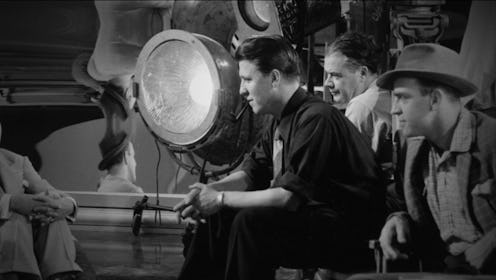Entertainment
Netflix Is Now Filled With World War II Documentaries

Netflix can now boast that it has an original series featuring Meryl Streep, Steven Spielberg, Guillermo del Toro, and even more impressive talent, thanks to Five Came Back. Based on Mark Harris’ best-selling book of the same name, the docuseries, which premiered on March 31, tells the story of how Hollywood changed World War II, and how World War II changed Hollywood. The three-part series sheds light on five filmmakers — John Ford, William Wyler, John Huston, Frank Capra, and George Stevens — who served their country in WWII and then shared their stories with America. And to coincide with the release of the docuseries, Netflix is also streaming some of the documentaries from Five Came Back.
The stories about these legendary directors unfold in the documentary series through interviews with Spielberg, del Toro, Francis Ford Coppola, Paul Greengrass, and Lawrence Kasdan, and those still aren't the only notable names involved. Five Came Back is directed by Laurent Bouzereau, written by Harris, narrated by Meryl Streep, and executive produced by Steven Spielberg, Scott Rudin, and Barry Diller.
That impressive group came together with specific goals in mind, and in a press release from Netflix, Bouzereau said that one was to educate a new generation of viewers about the five directors and their work. So, in conjunction with the release of Five Came Back, Netflix is featuring 13 documentaries from the WWII-era directors so that you can see some of the work described and sampled in Five Came Back for yourself.
'How To Operate Behind Enemy Lines' (1943, John Ford)
The synopsis for How To Operate Behind Enemy Lines on TCM has everything: war, espionage, exclusivity. The TCM write-up states: "The hour-long production, a how-to film woven into a dramatic narrative, was the first film to teach practical spycraft to wartime intelligence agents and was made for military use only, unseen by civilians until it was eventually declassified. Even now the film is rarely seen and often overlooked in John Ford filmographies. While it's not exactly John Ford's lost spy film, it's an oddly entertaining production designed to hold the attention of viewers while imparting information and advice."
'The Battle Of Midway' (1942, John Ford)
John Ford's 1942 Academy Award-winning documentary short about the Battle of Midway features narration from Henry Fonda and other Hollywood notables of the era.
'Let There Be Light' (1946, John Huston)
Let There Be Light had been suppressed by the Army until 1980, but upon its release was found to be in poor quality, as reported by The Washington Post. But in 2012, it was finally being restored and released, and now the documentary about the psychological effect that WWII had on soldiers can be found on Netflix.
'Tunisian Victory' (1944, John Huston)
Many scenes in Tunisian Victory were created with re-enactments shot in the Mojave Desert in the U.S., according to TCM. The film's purpose was to give American audiences a glimpse at war in North Africa. TCM's synopsis explains that some of the most powerful scenes were not the recreated battles, but instead the shots of " U.S. and British soldiers relaxing between battles, including a touching Christmas scene."
'Report From The Aleutians' (1943, John Huston)
Report From The Aleutians focuses on the daily lives of soldiers on Adak Island, according to The Atlantic.
'Know Your Enemy - Japan' (1945, Frank Capra)
This American propaganda film was commissioned by the U.S. War Department and as explained in Five Came Back, depicted Japanese people in an incredibly offensive, harmful way.
'The Negro Soldier' (1944, Stuart Heisler; Produced By Frank Capra)
According to TCM, The Negro Soldier was made because of a request from General Frederick Osborn, head of the army's Morale Branch. Racism, segregation, and Jim Crow laws caused black citizens to be wary about enlisting — and white recruits had prejudices. TCM explains that the film was made "to show African Americans why this was their war too and show white soldiers and civilians that African Americans were both fellow citizens and soldiers."
'The Battle Of Russia' (1943, Frank Capra)
The Battle of Russia was fifth installment from Capra's Why We Fight propaganda docuseries.
'Prelude To War' (1942, Frank Capra)
Prelude To War was the first installment of the Why We Fight series.
'Nazi Concentration Camps' (1945, George Stevens)
This graphic film was made up of Stevens' (pictured above) footage from the liberation of concentration camps and showed the full extent of what had been happening there. As Five Came Back explains, it was actually used as evidence in the Nuremberg war crimes trial of multiple Nazi leaders.
'Thunderbolt' (1947, William Wyler)
Thunderbolt is about the P-47 Thunderbolt fighter aircraft and its World War II missions. The film's introduction is by Jimmy Stewart, who had commanded a bomber wing during the war.
'The Memphis Belle: A Story Of A Flying Fortress' (1944, William Wyler)
According to Rotten Tomatoes, The Memphis Belle: A Story Of A Flying Fortress includes "footage from several allied bombing missions." The website also praises the film for its inspiration without grandstanding. The synopsis states: "As calm-voiced narrator Ed Kern explains, the Belle has a job to do, and it does it, and that's all. The danger facing these Flying Fortresses is underlined, but never overemphasized, by brief glimpses of those doomed ships that didn't make it back."
So if you're a history buff, between Five Came Back and these documentaries, prepare for a lengthy Netflix marathon.